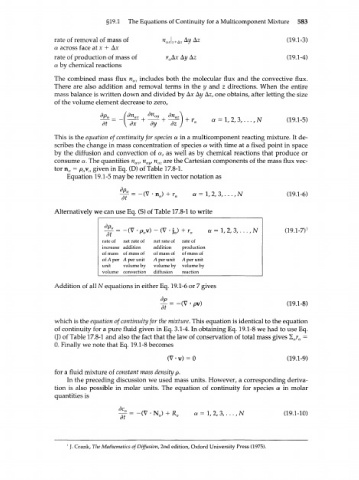Page 603 - Bird R.B. Transport phenomena
P. 603
§19.1 The Equations of Continuity for a Multicomponent Mixture 583
rate of removal of mass of (19.1-3)
a across face at x + Ax
rate of production of mass of r &x Ay Az (19.1-4)
a
a by chemical reactions
The combined mass flux n includes both the molecular flux and the convective flux.
ax
There are also addition and removal terms in the у and z directions. When the entire
mass balance is written down and divided by Ax Ay Az, one obtains, after letting the size
of the volume element decrease to zero,
(19.1-5)
dt
This is the equation of continuity for species a in a multicomponent reacting mixture. It de-
scribes the change in mass concentration of species a with time at a fixed point in space
by the diffusion and convection of a, as well as by chemical reactions that produce or
consume a. The quantities n , n , n are the Cartesian components of the mass flux vec-
ax ay az
tor n a = p v given in Eq. (D) of Table 17.8-1.
a a
Equation 19.1-5 may be rewritten in vector notation as
= 1, 2, 3, (19.1-6)
Alternatively we can use Eq. (S) of Table 17.8-1 to write
-(V-p v) - (V • U + r a = 1, 2, ,..., N (19.1-7) 1
3
dt e a
rate of net rate of net rate of rate of
increase addition addition production
of mass of mass of of mass of of mass of
of A per A per unit A per unit A per unit
unit volume by volume by volume by
volume convection diffusion reaction
Addition of all N equations in either Eq. 19.1-6 or 7 gives
(19.1-8)
which is the equation of continuity for the mixture. This equation is identical to the equation
of continuity for a pure fluid given in Eq. 3.1-4. In obtaining Eq. 19.1-8 we had to use Eq.
(J) of Table 17.8-1 and also the fact that the law of conservation of total mass gives X r =
a a
0. Finally we note that Eq. 19.1-8 becomes
(V • v) = 0 (19.1-9)
for a fluid mixture of constant mass density p.
In the preceding discussion we used mass units. However, a corresponding deriva-
tion is also possible in molar units. The equation of continuity for species a in molar
quantities is
? = -(V-N ) a = 1,2,3 N (19.1-10)
dt a
J. Crank, The Mathematics of Diffusion, 2nd edition, Oxford University Press (1975).
1

